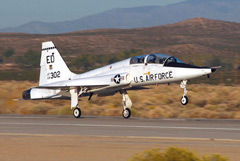
| Arnold Engineering Development
Center Helps to Improve the T-38 |
|
|
6/24/2008 - ARNOLD AIR FORCE BASE, TN -- Arnold Engineering Development Center recently collaborated with the Air Force Flight Test Center at Edwards Air Force Base, Calif., to help quantify performance improvements of a T-38 Talon. The twin-engine, high-altitude T-38 was the first world's first supersonic trainer, originally designed in the 1950s. "The T-38 is a critical Air Force asset for training future fighter and bomber pilots," said Capt. Chuck McNiel, 704th Test Systems Group technology program lead at AEDC. "The analysis and evaluation provided by Edwards and AEDC, in conjunction with T-38 flight testing, has greatly enhanced the decision-making process for the users in choosing the best aircraft configuration for the Air Education and Training Command." The partnership between the test centers is providing near and long-term benefits for the T-38 and all of its users, Captain McNiel said. The analysis efforts benefited from an on-going technical excellence initiative, said David Kidman, AFFTC propulsion integration flight test branch technical expert. Both Arnold Engineering Development Center and the AFFTC are collaborating to develop and apply state-of-the-art analysis capabilities, strengthening the government's role in test and evaluation and acquisition processes. "An over-arching goal of the technical excellence initiative is for the two centers to integrate ground test, flight test and modeling and simulation," said Dr. Don Malloy, technical lead and project manager for collaborative projects between the two centers. "This is to reduce the time and cost of developmental testing and maximize knowledge derived from testing." Recent upgrades to the T-38's engine and airframe challenged propulsion integration engineers, Dr. Malloy said. "The Air Force modernized the engine to get more life out of the engine and reduce maintenance costs" he said. "They also upgraded the inlet and ejector nozzle on the engines to provide better hot-day takeoff performance and lower specific fuel consumption at cruise conditions." One of the goals of the propulsion modernization program was to obtain the highest possible performance out of the engine and aircraft without adversely affecting engine operability. "The J85-5 engines in the T-38 aircraft do not have modern digital engine controllers found in the current generation of Air Force fighter engines," said Benjamin Tomlinson, propulsion integration engineer with the 773rd Test Squadron at Edwards. "Without a full authority digital electronic controller, compressor stalls during aircraft maneuvers are possible. Engine and aircraft manufacturers were challenged to improve the performance of the integrated engine and aircraft system. They needed to ensure that the occurrence of compressor stalls remained below the stall rate with the legacy engines." A compressor stall is characterized by an abnormal airflow inside a jet engine that can result from a stall of the blades within the compressor's rotor, Mr. Tomlinson said. This is similar to what happens when the airflow of an aircraft's wing fails to produce lift. Compressor stall can lead to a complete reversal in the direction of airflow and loss of compression throughout the engine, commonly known as a compressor surge. Two key challenges that the AEDC team helped their counterparts at Edwards tackle were base-lining compressor operation and estimating the effects of temperature distortion, Dr. Malloy said. "Our role was to help characterize compressor operation during propulsion flight tests, and one of the challenges is they don't have the same instrumentation we have available during ground tests," Dr. Malloy said. "Safety of test and flight are critical and any instrumentation added to the engine has to be flight certified. As a result, few internal engine measurements are typically available in flight. model-based analysis approaches are required to characterize compressor operation with a limited number of flight test measurements." The collaborative effort with AEDC was an excellent experience, Mr. Tomlinson said. "The tools being developed are exactly what a legacy aircraft like the T-38 needs," he said. "We will continue to work with AEDC to upgrade our analysis tools to support T-38 engine operability flight tests at the Air Force Flight Test Center later this summer." The Arnold Engineering Development Center and AFFTC analysis is on par or better than airframe and engine manufacturer analysis in support of the T-38 program, Mr. Kidman said. "It is also clear the Air Force's technical excellence initiatives to develop and apply state-of-the-art analysis capabilities are working," he said. Source: USAF Edwards AFB Press Release by by Philip Lorenz III |
| |
